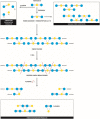Management of the thrombotic risk associated with COVID-19: guidance for the hemostasis laboratory
- PMID: 32922211
- PMCID: PMC7474970
- DOI: 10.1186/s12959-020-00230-1
Management of the thrombotic risk associated with COVID-19: guidance for the hemostasis laboratory
Abstract
Coronavirus disease 2019 (COVID-19) is associated with extreme inflammatory response, disordered hemostasis and high thrombotic risk. A high incidence of thromboembolic events has been reported despite thromboprophylaxis, raising the question of a more effective anticoagulation. First-line hemostasis tests such as activated partial thromboplastin time, prothrombin time, fibrinogen and D-dimers are proposed for assessing thrombotic risk and monitoring hemostasis, but are vulnerable to many drawbacks affecting their reliability and clinical relevance. Specialized hemostasis-related tests (soluble fibrin complexes, tests assessing fibrinolytic capacity, viscoelastic tests, thrombin generation) may have an interest to assess the thrombotic risk associated with COVID-19. Another challenge for the hemostasis laboratory is the monitoring of heparin treatment, especially unfractionated heparin in the setting of an extreme inflammatory response. This review aimed at evaluating the role of hemostasis tests in the management of COVID-19 and discussing their main limitations.
Keywords: Anticoagulation; COVID-19; Coagulopathy; D-dimers; Fibrinolysis; Hemostasis; Heparin; Thrombin generation; Thrombosis; Viscoelastic tests.
© The Author(s) 2020.
Conflict of interest statement
Competing interestsThe authors declare no competing interest.
Figures

Similar articles
-
[Management of the thrombotic risk associated with COVID-19: what is the role of the hemostasis laboratory?].Ann Biol Clin (Paris). 2020 Oct 1;78(5):471-481. doi: 10.1684/abc.2020.1581. Ann Biol Clin (Paris). 2020. PMID: 33026344 Review. French.
-
Viscoelastic Tests in the Evaluation of Haemostasis Disturbances in SARS-CoV2 Infection.Acta Med Port. 2021 Jan 4;34(1):44-55. doi: 10.20344/amp.14784. Epub 2020 Nov 5. Acta Med Port. 2021. PMID: 33159728 Review.
-
Prevention of thrombotic risk in hospitalized patients with COVID-19 and hemostasis monitoring.Crit Care. 2020 Jun 19;24(1):364. doi: 10.1186/s13054-020-03000-7. Crit Care. 2020. PMID: 32560658 Free PMC article. Review.
-
COVID-19-related laboratory coagulation findings.Int J Lab Hematol. 2021 Jul;43 Suppl 1(Suppl 1):36-42. doi: 10.1111/ijlh.13547. Int J Lab Hematol. 2021. PMID: 34288440 Free PMC article. Review.
-
[Guidelines for prophylaxis and anti-thrombotic treatment for patients with COVID-19. Consensus of the Latin American Cooperative Group on Hemostasis and Thrombosis (CLAHT)].Arch Cardiol Mex. 2021 Dec 20;91(Suplemento COVID):047-054. doi: 10.24875/ACM.20000291. Arch Cardiol Mex. 2021. PMID: 33459726 Free PMC article. Review. Spanish.
Cited by
-
Point of care ultrasound screening for deep vein thrombosis in critically ill COVID-19 patients, an observational study.Thromb J. 2021 Jun 2;19(1):38. doi: 10.1186/s12959-021-00272-z. Thromb J. 2021. PMID: 34078399 Free PMC article.
-
Meta-Analysis and Systematic Review of Coagulation Disbalances in COVID-19: 41 Studies and 17,601 Patients.Front Cardiovasc Med. 2022 Mar 11;9:794092. doi: 10.3389/fcvm.2022.794092. eCollection 2022. Front Cardiovasc Med. 2022. PMID: 35360017 Free PMC article.
-
Clot waveform of APTT has abnormal patterns in subjects with COVID-19.Sci Rep. 2021 Mar 4;11(1):5190. doi: 10.1038/s41598-021-84776-8. Sci Rep. 2021. PMID: 33664450 Free PMC article.
-
Cerebrospinal fluid dynamics coupled to the global circulation in holistic setting: Mathematical models, numerical methods and applications.Int J Numer Method Biomed Eng. 2022 Jan;38(1):e3532. doi: 10.1002/cnm.3532. Epub 2021 Oct 19. Int J Numer Method Biomed Eng. 2022. PMID: 34569188 Free PMC article.
-
Soluble platelet selectin and platelets in COVID-19: a multifaceted connection.Ann Med Surg (Lond). 2024 Jun 20;86(8):4634-4642. doi: 10.1097/MS9.0000000000002302. eCollection 2024 Aug. Ann Med Surg (Lond). 2024. PMID: 39118706 Free PMC article. Review.
References
-
- Iba T, Levy JH. Inflammation and thrombosis: roles of neutrophils, platelets and endothelial cells and their interactions in thrombus formation during sepsis. J Thromb Haemost. 2018;16(2):231–241. - PubMed
-
- Levi M, Poll T. Coagulation in patients with severe sepsis. Semin Thromb Hemost. 2015;41(1):9–15. - PubMed
Publication types
LinkOut - more resources
Full Text Sources

